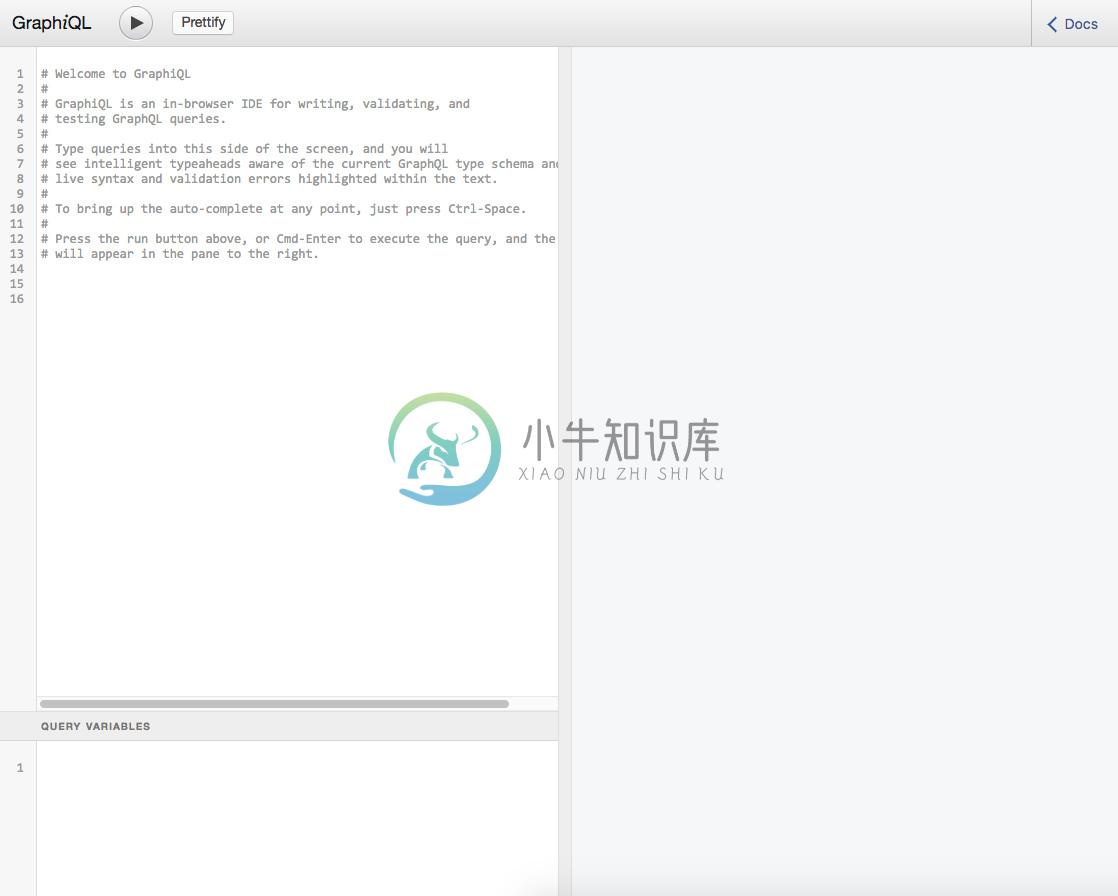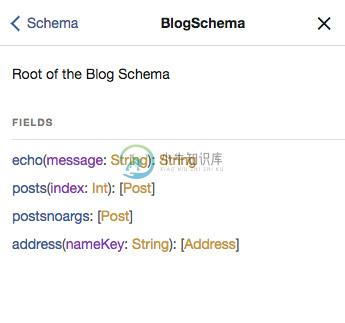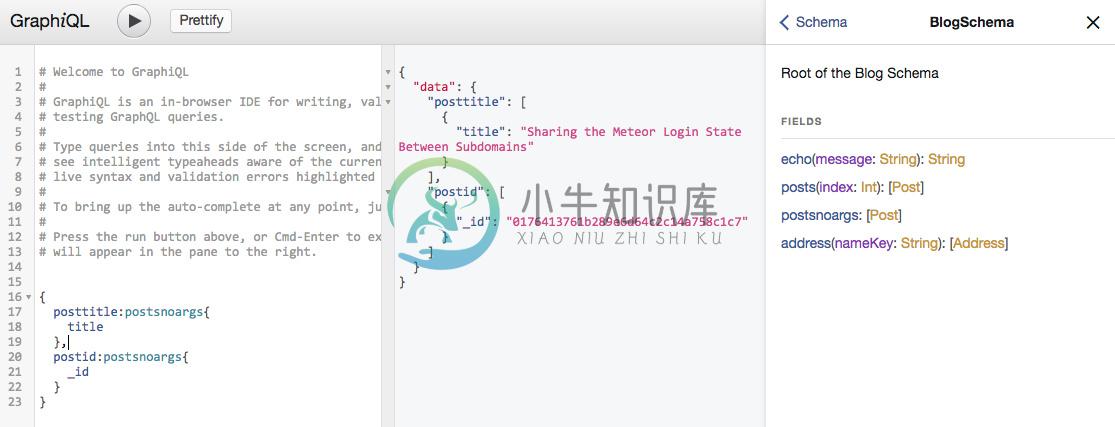查询
Graphql 为查询而生,所以我们首先试试它的查询功能吧.
准备工作
- 克隆库:
git clone https://github.com/zhouyuexie/learn-graphql
- 安装依赖:
cd learn-graphql && npm install
- 运行:
npm start
现在打开你的浏览器输入http://localhost:12580/graphql,或者点击这里.

GraphQL 初试
在左边窗口输入以下内容:
{echo(message:"world")}
你会在右边窗口看到这个返回的数据:
{"data": {"echo": "hello: world"}}
提示:右上角有个Docs,点击它你可以看到你可以看到有关查询的信息.

你可以看到上面那行echo(message:String):String,说明echo接受一个message的参数,并且返回一个string类型的数据,点击echo你可以看到更详细的内容.
有参数查询
上面
echo只是一个简单的演示,并没有查询字段,现在我们开始根据客户端的要求返回定制的数据吧.
现在让你查询posts你应该知道怎么开始了吧?对的,我们想看文档,点击右上角开始吧.
上图就有你想要的东西,你会看到posts模式接受一个整数型的index,然后返回一个Post类型数据,我们开始试试吧:
{posts(index:1){_id,title,content}}
大概返回如下数据:
{"data": {"posts": [{"_id": "03390abb5570ce03ae524397d215713b","title": "New Feature: Tracking Error Status with Kadira","content": "Here is a ...."}]}}
无参数查询
目前为止我们的查询都需要一个参数,毕竟查询的时候大多数都是需要参数的,现在我们来试试一个不需要参数的例子.
{postsnoargs{_id,title,content}}
好了,执行一下吧!你会发现没什么不同,就是服务器返回的数据是”固定”的而已,对于获取一些首页这类数据我们不需要给定参数是非常有用的.
嵌套查询
有时候我们需要对查询到的数据进行筛选,比如限制大小,这时候就需要一个嵌套查询来实现这个功能了.
比如下面这个查询A开头的全国省市信息:
{address(nameKey:"A"){ShortKey,Content(limit:5) {Id,Code,Name,FirstStr}}}
服务器返回:
{"data": {"address": [{"ShortKey": "A","Content": [{"Id": 36,"Code": "152900","Name": "阿拉善盟","FirstStr": "A"},{"Id": 39,"Code": "210300","Name": "鞍山市","FirstStr": "A"},{"Id": 105,"Code": "340800","Name": "安庆市","FirstStr": "A"},{"Id": 155,"Code": "410500","Name": "安阳市","FirstStr": "A"},{"Id": 293,"Code": "513200","Name": "阿坝藏族羌族自治州 ","FirstStr": "A"}]}]}}
其中的Content字段加上了限制返回前五个市的信息,注意其中的limit是服务器设置的,并不是Graphql的关键字.
多种查询混合
这其实很简单,也就是将上面的几个查询混合写到一起就可以了:
{address(nameKey:"A"){ShortKey,Content(limit:2) {Id,Code,Name,FirstStr}},posts(index:1){_id,title}}
服务器返回:
{"data": {"address": [{"ShortKey": "A","Content": [{"Id": 36,"Code": "152900","Name": "阿拉善盟","FirstStr": "A"},{"Id": 39,"Code": "210300","Name": "鞍山市","FirstStr": "A"}]}],"posts": [{"_id": "03390abb5570ce03ae524397d215713b","title": "New Feature: Tracking Error Status with Kadira"}]}}
查询别名
有时候我们想这样查找使数据分开,方便自己各个地方调用:
{postsnoargs{title},postsnoargs{_id}}
我们设想得到的数据是这样的:
{"data": {"postsnoargs": {"title":["title": "Sharing the Meteor Login State Between Subdomains",],"_id":["_id": "0176413761b289e6d64c2c14a758c1c7"]}}}
但其实服务器返回的是这样的:
{"data": {"postsnoargs": [{"title": "Sharing the Meteor Login State Between Subdomains","_id": "0176413761b289e6d64c2c14a758c1c7"}]}}
这时候我们就需要设置别名了,否则服务器返回的时候会合并你的数据:
{posttitle:postsnoargs{title},postid:postsnoargs{_id}}
服务器返回:
{"data": {"posttitle": [{"title": "Sharing the Meteor Login State Between Subdomains"}],"postid": [{"_id": "0176413761b289e6d64c2c14a758c1c7"}]}}

总结
以上就是你使用Graphql查询所需要知道的,下面我们开始介绍Mutations.

